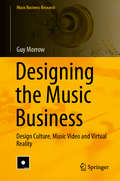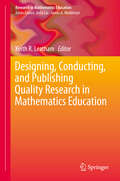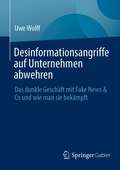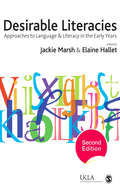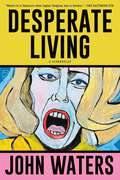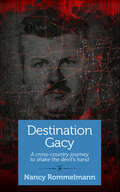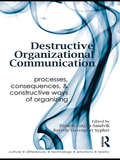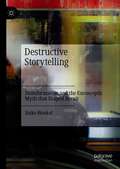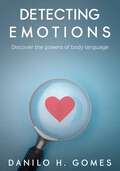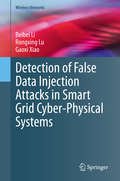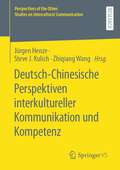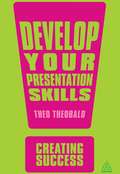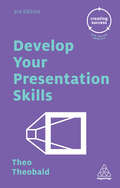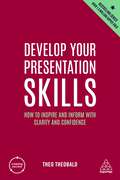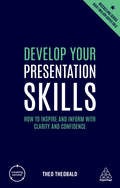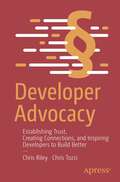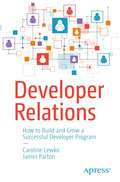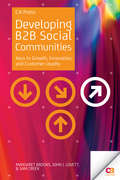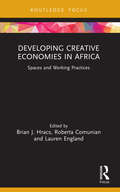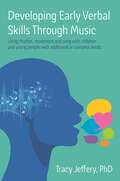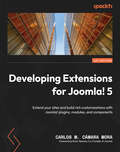- Table View
- List View
Designing the Music Business: Design Culture, Music Video and Virtual Reality (Music Business Research)
by Guy MorrowThis book addresses the neglect of visual creativities and content, and how these are commercialised in the music industries. While musical and visual creativities drive growth, there is a lack of literature relating to the visual side of the music business, which is significant given that the production of meaning and value within this business occurs across a number of textual sites.Popular music is a multimedia, discursive, fluid, and expansive cultural form that, in addition to the music itself, includes album covers; gig and tour posters; music videos; set, stage, and lighting designs; live concert footage; websites; virtual reality/augmented reality technologies; merchandise designs; and other forms of visual content. As a result, it has become impossible to understand the meaning and value of music without considering its relation to these visual components and to the interrelationships between them. Using design culture theory, participant observation, interviews, case studies, and a visual methodology to explore the topic, this research-based book is a valuable study aid for undergraduate and postgraduate students of subjects including the music business, design, arts management, creative and cultural industries studies, business and management studies, and media and communications.
Designing, Conducting, and Publishing Quality Research in Mathematics Education (Research in Mathematics Education)
by Keith R. LeathamThe purpose of this book is to collect, organize and disseminate collective wisdom with respect to designing, conducting, and publishing quality research in mathematics education. This wisdom will be gleaned from among those who, over the past several decades, have been instrumental in guiding the field in the pursuit of excellence in mathematics education research—insightful editors, educative reviewers, prolific writers, and caring mentors. Each chapter is written to the novice researcher with the intent of aiding them in avoiding common pitfalls, navigating difficult intellectual terrain, and understanding that they are not alone in experiencing rejection, frustration, confusion, and doubt. This book differs from existing literature in the sense that it is written about the enterprise of designing, conducting and publishing research in mathematics education as opposed to being reports of the results of such work. It also differs in the sense that it is written with the intent to mentor the rising generation as opposed to capture the state of the field (as would happen in a handbook, for example). It is written for the express purpose of helping the field work collectively to aid in the often isolated enterprise of mentoring new researchers. The primary audience is a potentially wide one: graduate students, novice researchers, graduate faculty, advisors, and mentors – or anyone seeking to improve their own abilities to design, conduct, and publish quality research in mathematics education.
Desinformationsangriffe auf Unternehmen abwehren: Das dunkle Geschäft mit Fake News & Co und wie man sie bekämpft
by Uwe WolffFake News ist für die allermeisten ein Begriff, den sie mit Politik und politischen Kampagnen in Verbindung bringen. Die verheerenden Auswirkungen sind bekannt (Brexit, Trump, AfD) Doch erst jetzt realisieren Unternehmen und Unternehmenslenker, dass auch sie Zielscheibe von Fake News werden können. Die ersten Unternehmen in Deutschland haben diese Desinformationsattacken bereits zu spüren bekommen. Die Folge: Wertverfall des Unternehmens, Aktienabstürze, Reputationsschaden sowie verunsicherte Mitarbeiter, Geschäftspartner und Banken. Die Ziele und Motive der Kommunikationsattacken sind vielfältig: Sie reichen von verärgerten Ex-Mitarbeitern, aggressiven Mitbewerbern bis hin zu Hedge-Fonds, die ein Unternehmen übernahmereif schießen wollen oder auf fallende Aktienwerte wetten. Den modernen Kommunikationsattacken steht ein wirkungsvolles und breit gefächertes Waffenarsenal im Bereich Internet und Social Media zur Verfügung, mit denen sich Fake News in Minutenschnelle Wirksam verbreiten lassen, sodass Unternehmen kaum mehr die Zeit haben, sich dagegen wirkungsvoll zu wehren. Dieses Buch richtet den Blick auf die neue Situation, in der sich die Unternehmen empfinden, und beschreibt die die empfindlichen Stellen. Es erläutert Kommunikationsattacken anhand von Beispielen und liefert zudem eine Handreichung für Unternehmen in Sachen Prävention und Detektion, aber auch im Abwehrkampf gegen gezielte unternehmensschädigende Informationsattacken.
Desirable Literacies: Approaches to Language and Literacy in the Early Years (Published in association with the UKLA)
by Elaine Hallet Jackie MarshWhat are the ways in which young children learn to communicate? Collating their extensive experience of language and literacy in the early years, the contributors explore key aspects of this topic, linking practical ideas for early years settings and classrooms to relevant theory and research. This second edition is updated to take into account important developments in research, policy and practice, and now covers the 0-8 age range. It also addresses developments in new media and the impact this has upon literacy in young children, and offers chapters on new areas which have emerged in recent years, such as multimodality, media literacy, creative arts and literacy. Explored in the book are: - the relationship between play and literacy; - the role environmental print has in early literacy development; - the language and literacy development of young bilinguals; - ideas, suggestions and justifications for the use of poetry; - a two-year research project, funded by Creative Partnerships; and - key issues relating to family literacy.
Desperate Living: A Screenplay
by John WatersA grotesque and hilarious satire about the American dream, suburban living, and the corrupting influence of power, set in a world that could only have sprung from the unhinged and brilliant mind of John Waters.On the verge of a suburban mental health crisis, frazzled and wildly unstable housewife Peggy (immortalized by Mink Stole on-screen) runs away from home with her maid and partner in crime, Grizelda (played with spectacular gumption by the sizzling Jean Hill), only to end up in Mortville, a shantytown filled with society’s rejects. Mortville is run by the evil Queen Carlotta, who parades through the cardboard streets taunting and terrorizing her subjects.John Waters’ wild and visionary fable lampoons everything from the staid conservatism of the American dream to race and class relations. The New York Times ranked Desperate Living at “the highest peak atop [John Waters’] trash heap of a filmography.” High praise indeed!
Destination Gacy: A Cross-Country Journey to Shake the Devil's Hand
by Nancy RommelmannIn 1994, journalist Nancy Rommelmann accompanied Rick Gaez, a 26-year-old pen pal of John Wayne Gacy, on a road trip from Los Angeles to Illinois, to visit the serial killer before his execution. Along the way, she took the moral temperature of people on college campuses, in bars, in churches, asking how they felt about Gacy and his being sentenced to death, for the torture and murder of 33 young men and teenage boys. Shackled in a tiny visiting room on death row, Gacy nevertheless turned on the charm. Chatty, slick, acting the father figure, albeit one who wants to know a little too much about your sex life, Gacy offered his hand and said, “Ask anything you want—I’m not ashamed of anything I’ve ever done.”
Destructive Organizational Communication: Processes, Consequences, and Constructive Ways of Organizing (Routledge Communication Series #Vol. 10)
by Pamela Lutgen-Sandvik Beverly Davenport SypherThis volume provides an in-depth consideration of destructive communication in organizations -- including workplace bullying, racism, stress, and harassment. It brings together communication scholars from theoretical and applied perspectives to assess current understandings, explore ways to integrate theory and practice, identify areas for change, and outline a research agenda for the coming decade. Each chapter examines a specific aspect of destructive organizational communication, reviews existing theory and research about that communicative form or ideology, suggests fruitful possibilities for application, and suggests key areas for further study. As such, the book opens a dialogue among communication scholars that explores destructive communication in organizations and addresses the following key components: the central issues and concerns regarding destructive organizational communication, current scholarly contributions to both applied and theoretical understanding of these issues, approaches to integrate applied/experienced and theoretical/conceptual perspectives in ways that inform one another and improve organizational considerations for varied stakeholders, and suggestions for a future research agenda for those interested in ameliorating the destructive side of organizational communication. Overall, the collection provides a basic understanding of the different types of destructive communication in organizations, the processes through which these interactions occur, the consequences to individuals and organizations, and the potential for organizing in more constructive, civil ways. This volume will be an excellent resource for scholars and researcher studying organizational communication, and graduate and advanced undergraduate students in organizational communication. It will also resonate with managers dealing with hostile workplaces, and organizational members trying to understand their current experiences. The book will serve as an excellent textbook for advanced undergraduate and graduate courses in organizational communication.
Destructive Storytelling: Disinformation and the Eurosceptic Myth that Shaped Brexit
by Imke HenkelThis book offers a new approach to understanding disinformation and its destructive impact on the democratic function of the news media. Using the notoriously false reporting of EU policies by the British press as a starting point, it utilises Critical Discourse Analysis to examine the linguistic properties of false news stories and to understand how they function as myth in Roland Barthes’ sense. The disinformation is essential for the impact these news stories had as it provides the simplification which creates the blissful clarity of myth that Barthes described. As myth, the false news stories depoliticised a political argument and naturalised the claim of antagonistic British-European relations. Henkel shows how news stories used disinformation to articulate a Eurosceptic myth of the feisty, witty Briton who stands up against the European bully. Her main argument is that the disinformation contributed to the Brexit vote because, as myth, it transported an ideology. Henkel argues that the Brexit debate and the news reporting that preceded it for decades can be understood as a case study for how political journalism becomes democratically dysfunctional. This book will be of interest to students and scholars of journalism, media and culture, political communication, and Critical Discourse Analysis.
Detectando Emociones: Descubra los poderes del lenguaje corporal
by Danilo H. GomesAprenda a través de este libro, a “detectar” las emociones escondidas en cada gesto humano. Fruto de muchas búsquedas, “Detectando Emociones” es un óptimo libro para quien quiera aprender, de forma rápida e directa, los significados escondidos por atrás de cada movimiento humano. Mas allá de eso también aprenda, a través de la Proxémica, el significado escondido por atrás de la distancia que un individuo permanece en relación con otro durante una simple conversación. Qué tal conocer también las técnicas usadas para descubrir una mentira. Ellas también están presentes en este libro. Aprenda 17 señales sospechosas que revelan una mentira. Esto y mucho más usted encontrará en las páginas de este humilde libro. Ciencia pura, sin complicaciones.
Detecting Emotions: Discover the powers of body language
by Danilo H. GomesThis book is for anyone with curiosity about reading the body language. It is a description of body reactions during a conversations and how we can read them with their meanings singular. Also, this book is for the ones who want to improve their abilities to help those in need with depression, anxiety and deep sadness. This is the perfect reading for those who feel like getting to know more about this fascinating content.
Detection of False Data Injection Attacks in Smart Grid Cyber-Physical Systems (Wireless Networks)
by Rongxing Lu Gaoxi Xiao Beibei LiThis book discusses cybersecurity issues of smart grid cyber-physical systems, focusing on the detection techniques against false data injection attacks. The authors discuss passive and proactive techniques that combat and mitigate two categories of false data injection attacks, false measurement data injections and false command data injections in smart grid cyber-physical systems. These techniques are easy to follow for either professionals or beginners. With this book, readers can quickly get an overview of this topic and get ideas of new solutions for false data injections in smart grid cyber-physical systems. Readers include researchers, academics, students, and professionals.Presents a comprehensive summary for the detection techniques of false data injection attacks in smart grid cyber-physical systems; Reviews false data injections for either measurement data or command data; Analyzes passive and proactive approaches to smart grid cyber-physical systems.
Deutsch-Chinesische Perspektiven interkultureller Kommunikation und Kompetenz (Perspectives of the Other. Studies on Intercultural Communication)
by Zhiqiang Wang Jürgen Henze Steve J. KulichWie gestaltet sich Interkulturelle Kommunikation als wissenschaftliche Disziplin in China und Deutschland im Vergleich? Inwieweit gibt es Unterschiede und Ähnlichkeiten im Kulturverständnis? Inwieweit wird die Entwicklung interkultureller Kompetenz als disziplinübergreifende Herausforderung in Studium und Beruf verfolgt und wo gibt es Übereinstimmungen oder Besonderheiten im Verständnis, dem Design und den Formen der Vermittlung? Die Beitragenden zu diesem Sammelband sind seit Jahren in Lehre und Forschung mit Fragen interkultureller Kommunikation beschäftigt, als Vertreterinnen und Vertreter der Disziplin oder als perspektivisch Betroffene in anderen Wissenschaftsbereichen, in denen Interkulturalität zur zentralen Lebens- und Arbeitsperspektive/Praxis gehört.
Deutsche Kino-Wochenschau und der wirtschaftliche Aufschwung in West und Ost: Audiovisuelle Gestaltung und Vermittlungsstrategie in Fallanalysen (1950-1965)
by Sigrun LehnertIn der Zeit des wirtschaftlichen Aufschwungs Deutschlands nach dem Zweiten Weltkrieg waren die Wochenschauen im Vorprogramm jeder Kinovorstellung eine bedeutende Informationsquelle. Mit eindrucksvollen Bildern auf einer großen Leinwand – begleitet von gesprochenem Kommentar, Musik und Geräusch – gaben sie Orientierung und prägten die Erinnerung. In zahlreichen dokumentarischen Film- und Fernsehformaten werden bis heute einzelne Bilder oder kurze Sequenzen aus der Kino-Wochenschau als historische Belege, als Illustrationen oder zur Dramatisierung verwendet. Die außergewöhnlichen Prinzipien der Informationsvermittlung kommen dabei jedoch nicht mehr zur Geltung. Um das Publikum zu erreichen, war damals eine Mischung aus informativen Berichten und unterhaltenden Beiträgen unerlässlich. Die in diesem Buch vorgenommenen Fallanalysen spiegeln elementare Themenbereiche der Zeit des wirtschaftlichen Aufschwungs beider deutscher Staaten (1950-1965) wider. Neben den Prinzipien der audiovisuellen Gestaltung wird auch die zentrale Vermittlungsstrategie herausgearbeitet. Transmediale und transnationale Aspekte, die hierbei eine Rolle spielen, weisen die Wochenschau als Teil eines (internationalen) Mediensystems aus.
Develop Your Presentation Skills
by Theo TheobaldGoing beyond handling nerves and presenting PowerPoint slides, Develop Your Presentation Skills, 2nd edition, provides you with a practical toolkit for developing a belting presentation and improving your confidence along the way. Step-by-step advice includes practical help with unpicking the original brief, understanding just what the audience wants and constructing compelling content that will keep your audience rapt with attention. Complete with anecdotes and expert input to help you avoid disaster, this new edition includes two brand new chapters, helping you to deliver a presentation 'stripped bare' and how to use new media to engage with your audience. Develop Your Presentation Skills, 2nd edition, will help you find your voice and use it with style; to inform, to persuade, to impress.
Develop Your Presentation Skills
by Theo TheobaldDevelop Your Presentation Skills offers step-by-step realistic advice to improve your confidence, prepare effectively and nail that presentation.Going beyond just handling nerves and presenting PowerPoint slides, Develop Your Presentation Skills provides you with a practical toolkit for developing a belting presentation and improving your confidence along the way. It includes practical help with unpicking the original brief, understanding just what the audience wants, facing your performance demons and constructing compelling content that will keep your audience rapt with attention. Complete with anecdotes and expert input to help you avoid disaster, this new edition also includes two brand new chapters, which help you to deliver a presentation 'stripped bare' and to use new media to engage with your audience. Develop Your Presentation Skills will help you find your voice and use it with style; to inform, to persuade, to impress.The creating success series of books...With over one million copies sold, the hugely popular Creating Success series covers a wide variety of topics and is written by an expert team of internationally best-selling authors and business experts. This indispensable business skills collection is packed with new features, practical content and inspiring guidance for readers across all stages of their careers.
Develop Your Presentation Skills: How to Inspire and Inform with Clarity and Confidence (Creating Success #11)
by Theo TheobaldProvides step-by-step advice to prepare effectively and nail that presentation. This quick and easy guide provides a practical toolkit for developing a winning presentation and improving your confidence. Complete with case studies and expert input to help you avoid disaster, Develop Your Presentation Skills includes content to help you to deliver a presentation 'stripped bare' and to use new media to engage with your audience. This fully updated 5th edition now features even more practical exercises, useful templates and top tips to help you find your voice and use it with style; to inform, to persuade, to impress. From unpicking the original brief and understanding just what the audience wants, to facing your performance demons and constructing compelling content, you will keep your audience rapt with attention.The Creating Success series of books...Unlock vital skills, power up your performance and get ahead with the bestselling Creating Success series. Written by experts for new and aspiring managers and leaders, this million-selling collection of accessible and empowering guides will get you up to speed in no time. Packed with clever thinking, smart advice and the kind of winning techniques that really get results, you'll make fast progress, quickly reach your goals and create lasting success in your career.
Develop Your Presentation Skills: How to Inspire and Inform with Clarity and Confidence (Creating Success #68)
by Theo TheobaldDevelop Your Presentation Skills offers step-by-step advice to prepare effectively and nail that presentation. Going beyond just handling nerves and presenting slides, this quick and easy guide provides a practical toolkit for developing a winning presentation and improving your confidence along the way. From unpicking the original brief and understanding just what the audience wants, to facing your performance demons and constructing compelling content, you will keep your audience rapt with attention.Complete with anecdotes and expert input to help you avoid disaster, Develop Your Presentation Skills also includes content to help you to deliver a presentation 'stripped bare' and to use new media to engage with your audience. Fully updated for 2019, this 4th edition now features even more practical exercises, useful templates, and top tips to help you find your voice and use it with style; to inform, to persuade, to impress.The Creating Success series of books...Unlock vital skills, power up your performance and get ahead with the bestselling Creating Success series. Written by experts for new and aspiring managers and leaders, this million-selling collection of accessible and empowering guides will get you up to speed in no time. Packed with clever thinking, smart advice and the kind of winning techniques that really get results, you'll make fast progress, quickly reach your goals and create lasting success in your career.
Developer Advocacy: Establishing Trust, Creating Connections, and Inspiring Developers to Build Better
by Chris Riley Chris TozziNo matter which point you're currently at on the developer advocacy journey – whether you've already implemented a developer advocate function or you're exploring the possibility – this book is for you. This book provides actionable guidance that business and technology leaders can use to understand the benefits of advocacy, identify what goes into the function, and learn how to maximize the success of developer advocate teams.Developer advocacy is a role that is sometimes hard to quantify and build – but you feel it when you’re missing it. Companies are struggling to solidify advocacy despite a strong desire to do so and little guidance exists for businesses seeking to build a developer advocacy program or assess its effectiveness. This book will show you how to get an advocacy program in your business: the basics of having an advocacy program, what tasks and processes need to be set up, and how to identify key stakeholders. You'll see how companies of all types that sell to or engage with technical audiences can develop a developer advocacy strategy. Specifically, you'll learn what developer advocates do, how business can start an advocacy practice in your organization and how to scale and operationalize such a practice once it is in place. The book will further explore the metrics for measuring advocacy success and ways the scale advocacy teams internally and externally. The Power of Developer Advocacy explores the exciting career path of advocacy for developers and engineers. What You Will LearnDiscover what developer advocacy isDetermine which sorts of companies need the functionUnderstand what the primary strategic considerations for developer advocacy isWho This Book is For Existing and future advocacy leaders, would-be developer advocates, developer marketers and DevRel teams and leaders
Developer Relations: How to Build and Grow a Successful Developer Program
by Caroline Lewko James PartonIncreasingly, business leaders are either looking to start a new developer program at their company or looking to increase the impact of their existing DevRel program. In this context, software developers are finally recognized as legitimate decision makers in the technology buying process, regardless of the size of their organization. New companies are appearing with the sole purpose of making tools for developers, and even companies whose primary focus was elsewhere are waking up to the developer opportunity. Even as the need and demand for DevRel has grown, there are still re-occurring challenges for DevRel leaders. It is these challenges that this book addresses, covering all aspects of a DevRel program. It is an essential reference to professionalize the practice of developer relations by providing you with strategic, repeatable, and adoptable frameworks, processes, and tools, including developer segmentation and personas, and developer experience frameworks. In Developer Relations, you’ll find the answers to the following questions: How do we convince stakeholders to support a program?How do we go about creating a program?How do we make developers aware of our offer?How do we stand out from the crowd?How do we get developers to use our products?How do we ensure developers are successful using our products?How do we measure success?How do we maintain the support of our stakeholders? After reading this book you’ll have a clear definition of what developer relations is, the type of companies that engage in DevRel, and the scope and business models involved. What You Will Learn Discover what developer relations is and how it contributes to a company’s successLaunch a DevRel program Operate a successful program Measure the success of your programManage stakeholders Who This Book Is For Those interested in starting a new developer program or looking to increase the impact of their existing one. From executives to investors, from marketing professionals to engineers, all will find this book useful to realize the impact of developer relations.
Developing B2B Social Communities
by Margaret Brooks J. J. Lovett Sam CreekDeveloping B2B Social Communities: Keys to Growth, Innovation, and Customer Loyalty explains why business-to-business companies need a robust online community strategy to survive and flourish in today's changing economy and shows you how to design and execute your company's strategy successfully. Seminars, publications, market research, and customer care centers remain important tools in every B2B firm's toolbox for understanding, attracting, and serving customers while keeping them loyal. But in a world of fierce global price competition, increasing transparency of business practices, and ever-rising complexity, these traditional customer interaction channels are no longer enough for most B2B companies. That's why smart organizations--both large and small--are tapping into online communities to gain a huge competitive advantage: the ability to get much closer to customers and become more valuable to them. Developing B2B Social Communities delves into the generators of business value in online communities: immediate customer access to expert information within the company and from other customers; inexpensive delivery of custom technical help; demonstrations of how customers can to get the most from their products; and forums where customers can share tips, air gripes, reveal unmet needs, and suggest improvements. Three veteran community managers show you how to harness the knowledge of the crowd to help shape your company's strategic direction, develop new products and services, identify trends, sell more, serve customers more efficiently, and provide better product support. Fleshing out precepts with real-world examples and case studies, the authors detail the transformational opportunities--and pitfalls--for creating online communities. What you'll learn Why B2B companies of all sizes now need to make online communities an integral part of their operations to maintain or expand market share. How to create, launch, and manage customer communities. How to integrate communities into the business processes of an organization so they have the greatest impact. How to create clear strategies for the social community that support larger business goals. How to define and measure what you gain from hosting online communities. How to develop operational best practices that will provide the greatest ROI. Who this book is for This book is for all professionals in B2B organizations who are charged to improve customer service and loyalty, engage in ongoing research and collaboration with customers, increase sales, identify new product ideas, promote product utilization, provide superior customer service, or monitor industry trends. Readers who will benefit from Developing B2B Social Communities include community managers, C-level decision makers, strategy professionals, marketing directors and executives, customer care professionals, senior technology leaders, and actual and prospective community leaders. Table of Contents The Human Need to Connect Community as the Centerpiece of B2B Engagement Community Models Life Cycle and Maturity Models for Online Communities Community Management Case Study in Focus: CA Technologies Business Impact Through Community Developing B2B Social Communities
Developing Communication Skills
by Krishna Mohan Meera BanerjiDeveloping Communication Skills Text book by Krishna Mohan, Meera Banerji from Trinity Press, Laxmi Publication Pvt. Ltd., New Delhi.
Developing Creative Economies in Africa: Spaces and Working Practices (Routledge Contemporary Africa)
by Brian J. HracsBringing together the experience of academics and practitioners, this book discusses creative economies in Africa, focusing on changing dynamics related to working, co-working and clustering. The contributors in this volume examine how strategies and opportunities such as co-working spaces, clustering and hubs facilitate the emergence of creative industries in a range of African countries including Kenya, Uganda, South Sudan, Nigeria, Tanzania and South Africa. They also consider the importance of creative intermediaries in providing opportunities and platforms for the development of creative economies in Africa. The chapters present a range of case studies and practices that engage with how creative and cultural producers embrace some of the limits and challenges of their local context to creatively deliver opportunities for economic as well as social and cultural development in their cities and regions. This book will be of interest to students, scholars and professionals researching the creative economies in Africa across the humanities and social sciences. All the royalties from the publication of this book will be donated to the not-for-profit organisation The Craft and Design Institute (CDI) (https://www.thecdi.org.za/) in South Africa, supporting capacity building for young creative practitioners from disadvantaged backgrounds.
Developing Early Communication, Language and Learning Skills at Home: Creating Personalised Activity Packs for Parents
by Laura Osman Heidi ManouchehriDeveloping Early Communication, Language and Learning Skills at Home is full of tried-and-tested, practical activities for children developing their communication, language and learning skills including those with special educational needs and disabilities. This book provides parents, teachers and therapists with a range of playful and engaging activities to consolidate and develop children’s language and communication skills at home and school. Organised into five areas, the resource includes motivating activities around the themes of outdoor activities, daily routines, messy play, games for turn-taking and games to encourage creativity and make sense of the world. Features include: • 50 activities, each with a list of equipment, instructions, top tips, key vocabulary and ideas for extending the activity next time • Symbol boards for each activity to support children’s understanding and experiences • Photocopiable sheets for ease of use • Guidance on how to tailor activities to the interests and needs of the child to produce a personalised activity pack • An activity checklist to help you maximise your interactions with the child • An activity log to record children’s responses and achievements With clear and easy-to-follow instructions, the activities are suitable for use with children who are non-verbal, still developing their early communication or children who are talking. This is an invaluable resource for teachers, teaching assistants or therapists to share relevant activities with parents, and can equally be used by parents as a stand-alone resource. Designed to support the transfer of learning from school to home, this book will empower anyone working with children with SEND to develop children’s communication, language and learning through playful interactions.
Developing Early Verbal Skills Through Music: Using rhythm, movement and song with children and young people with additional or complex needs
by Tracy JefferyDrawing on current research about the connections between music and speech, this book explains how and why musical activities can be used to support the mechanisms and processes needed for speech. Containing specific guidance on the physiological, neurological, and learning differences children face when trying to make sense of speech, including hypermobility, autism spectrum conditions, Down Syndrome, auditory processing differences and motor timing difficulties, this guide provides an in-depth evaluation into how you can enhance your practice.Discover evidence-based and easy-to-use activities such as how to use whistles for breathing, drums to support the ability to 'hear' or produce speech sounds, and how to use songs to support speech.
Developing Extensions for Joomla! 5: Extend your sites and build rich customizations with Joomla! plugins, modules, and components
by Carlos M. MoraHarness the full potential of Joomla! through this comprehensive take on Joomla! extensions from conception through to releaseKey FeaturesDiscover the complete cycle of extension development from conception to releaseLeverage built-in features such as categories, ACL, and custom fields to enrich your extensionsLearn how to build extensions that integrate with the Joomla! API and the new Joomla! CLIPurchase of the print or Kindle book includes a free PDF eBookBook DescriptionJoomla! 5 is a groundbreaking CMS that helps you take a significant leap into the world of content management systems. Joomla! 5 features a variety of impressive new features that align with current web standards and enable you to experience lightning-fast performance for optimal web page optimization, leverage the new code architecture, and tap into the WebService API, among others. This book takes you on a journey of extending Joomla's capabilities by developing your own extensions. The chapters not only explain the key concepts behind Joomla's architecture but also equip you with the latest techniques for crafting components and plugins. You’ll discover how to leverage existing features within Joomla! to empower your extensions and create tailored solutions. The book takes you from the initial stages of planning your extension development to a fully featured finished product. As you advance, you'll learn invaluable techniques for testing your extension, addressing common issues, and preparing it for publication. The concluding chapters of this comprehensive guide teach you how to test your extension for common issues, along with how to publish the extension for everyone to use. By the end of this book, you’ll have the confidence and skills to complete the cycle of extension development.What you will learnFind out how to plan the development of a new extension from scratchUnderstand the basic structure of a Joomla! extensionGet to grips with the Joomla! Forms systemUse Joomla! features effectively to enrich your extensionsDiscover how to add a WebService API to your extensionCreate a Joomla! CLI command for your extensionDevelop a Joomla! Child Template for your projectsTest your extensions before the releaseWho this book is forThis book is for Joomla! developers and web designers who want to extend the functionalities of Joomla! and find innovative ways to customize their content management systems, e-commerce websites, business websites, and more. Basic familiarity with Joomla! will help you get the most out of this book.
